Diversity in the Living World NCERT Solutions | Science for Class 6 PDF Download
Let us Enhance our Learning
Q1: Here are two types of seeds. What differences do you find among the roots and leaf venation of their plants?
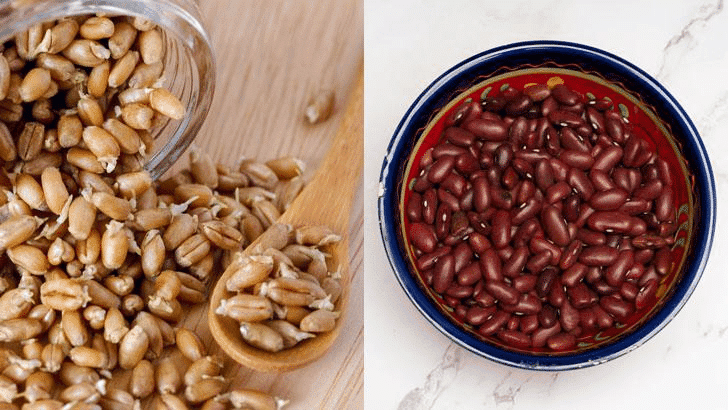 Wheat and Kidney Beans
Wheat and Kidney Beans
Ans: Differences in Roots and Leaf Venation
(a) Wheat
- Roots: Wheat has fibrous roots, which are thin, branched roots that spread out from the base of the stem.
- Leaf Venation: Wheat leaves have parallel venation, meaning the veins run side by side along the length of the leaf.
(b) Kidney Beans
- Roots: Kidney beans have a taproot system, where one main root grows straight down, and smaller side roots branch off from it.
- Leaf Venation: Kidney bean leaves have reticulate venation, where the veins form a network that spreads out from a central line across the leaf.
Q2: Names of some animals are given below. Group them based on their habitats. Write the names of aquatic animals in the area marked ‘A’ and terrestrial animals in the area marked ‘B’. Enter the names of animals living in both habitats in part ‘C’.
" Horse, Dolphin, Frog, Sheep, Crocodile, Squirrel, Whale, Earthworm, Pigeon, Tortoise"
 Ans: Grouping Animals based on their Habitats
Ans: Grouping Animals based on their Habitats
- Aquatic Animals (Area A): Dolphin, Whale
- Terrestrial Animals (Area B): Horse, Sheep, Squirrel, Pigeon, Earthworm
- Animals Living in Both Habitats (Area C): Frog, Crocodile, Tortoise
Q3: Manu’s mother maintains a kitchen garden. One day, she was digging out radishes from the soil. She told Manu that radish is a kind of root. Examine a radish and write what type of root it is. What type of venation would you observe in the leaves of the radish plant?
Ans: A radish has a taproot system, where a main root grows straight down and is larger than the other roots. This main root stores food and nutrients for the plant. The leaves of a radish plant have reticulate venation, meaning the veins on the leaf form a network-like pattern, with smaller veins branching off from the main vein.
Q4: Look at the image of a mountain goat and a goat found in the plains. Point out the similarities and differences between them. What are the reasons for these differences?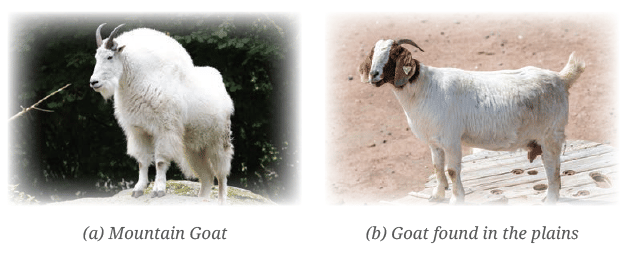 Ans:
Ans:
Similarities:
- Species: Both are goats and belong to the same family.
- Diet: Both are herbivores and eat plants.
- Body Structure: Both have hooves and horns.
Differences: Fur and Coat: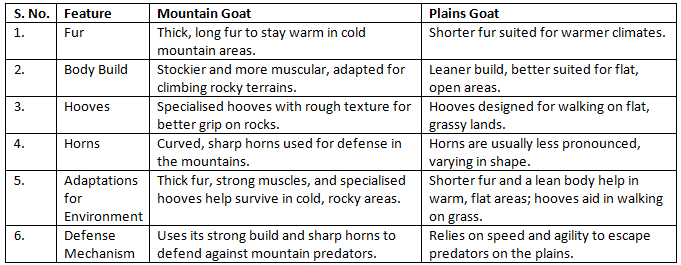
Reasons for differences: Adaptations to their respective habitats for efficient movement and survival.
Q5: Group the following animals into two groups based on any feature other than those discussed in the chapter—cow, cockroach, pigeon, bat, tortoise, whale, fish, grasshopper, lizard.
Ans:
These animals based on their habitat - animals that live on land (terrestrial) and animals that live in water (aquatic).
- Terrestrial Animals: Cow Cockroach Pigeon Bat Tortoise Grasshopper Lizard
- Aquatic Animals: Whale Fish
Q6: As the population grows and people want more comfortable lives, forests are being cut down to meet various needs. How can this affect our surroundings? How do you think we can address this challenge?
Ans:
Impact of Deforestation:
- Loss of Biodiversity
- Climate Change
- Soil Erosion
- Loss of Livelihoods
Addressing the Challenge:
- Reforestation and Afforestation
- Sustainable Logging Practices
- Protected Areas
- Education and Awareness
Q7: Analyse the flowchart. What can be examples of ‘A’ and ‘B’?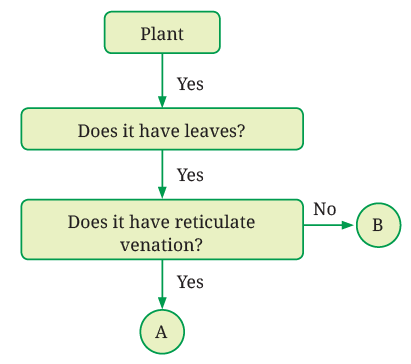 Ans:
Ans:
Examples of 'A':
- These are plants that have reticulate venation in their leaves.
- Examples: Mango, Hibiscus, Rose.
Examples of 'B':
- These are plants that do not have reticulate venation (i.e., they have parallel venation).
- Examples: Wheat, Maize, Grass.
Q8: Raj argues with his friend Sanjay that “Gudhal (hibiscus) plant is a shrub”. What questions can Sanjay ask for clarification?
Ans: Questions that Sanjay can ask for Clarification:
- What is the height of the Gudhal (hibiscus) plant? (Shrubs are typically medium-sized plants)
- What is the nature of its stem? (Shrubs have hard but not very thick stems)
- How do the branches of the Gudhal plant appear? (Shrubs typically have branches that arise close to the ground)
- Is the stem of the Gudhal plant woody? (Shrubs often have woody stems)
Q9: Based on the information in the table, find out examples of these plants for each group. Ans:
Ans:
Group A (Dicot, Taproot): Examples: Mango, Rose, Hibiscus
Group B (Monocot, Fibrous roots): Examples: Wheat, Maize, Rice
Q10: Observe the labelled part of a duck in the picture given below. What differences do you observe in the feet of the duck compared to the other birds? Which activity would the duck be able to perform using this part?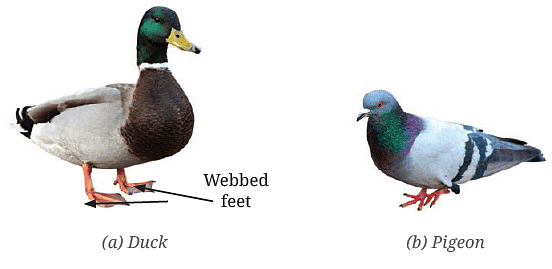 Ans:
Ans:
Differences in the Feet:
(a) Duck: Has webbed feet.
(b) Pigeon: Does not have webbed feet; has regular bird feet with separate toes.
Activities the Duck Can Perform with Webbed Feet:
- Swimming: The duck’s webbed feet enable it to paddle through water effectively.
- Walking on Muddy or Wet Surfaces: Webbed feet give the duck stability and help prevent it from sinking.
- The duck’s webbed feet are uniquely suited for swimming, allowing it to glide easily through the water.
|
68 videos|260 docs|27 tests
|
FAQs on Diversity in the Living World NCERT Solutions - Science for Class 6
| 1. What is diversity in the living world? |  |
| 2. Why is it important to study diversity in the living world? |  |
| 3. How do scientists classify living organisms based on diversity? |  |
| 4. What are the benefits of biodiversity in the living world? |  |
| 5. How can individuals contribute to the conservation of diversity in the living world? |  |

















